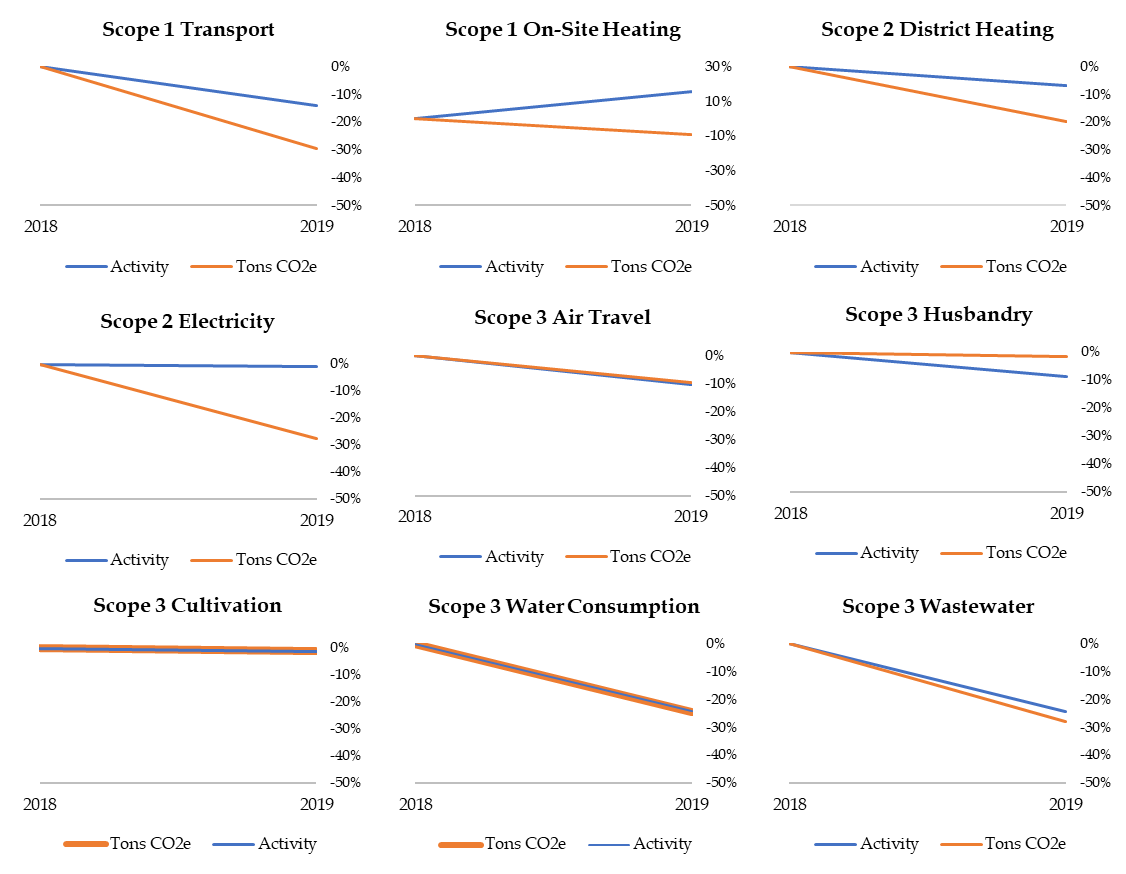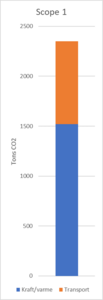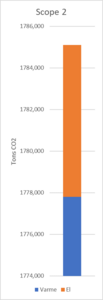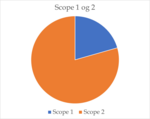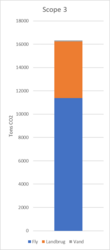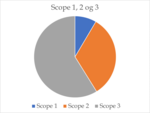Greenhouse gas emissions report 2019
This page has a summary of Aarhus University's greenhouse gas emissions report 2019. You can find the full report by clicking on the bar at the top right.
Aarhus University greenhouse gas emissions report 2019 – summary
AU's 2019 greenhouse gas emissions report (GHG emissions report) shows total university carbon emissions of 27,751.7 tonnes of CO2-eq, meaning there was a reduction of 15 per cent compared with 2018.
Much of the drop in carbon emissions by the university is linked to electricity and heating purchases. These have been reduced significantly, in part due to increased production of wind energy in Denmark.
There is also a significant reduction in direct emissions from AU because of more climate-friendly heat production with biogas and wood pellets rather than oil and gas.
Furthermore, there has been a reduction in water consumption by the university, and in the number of kilometres flown.
Results for scope 1
AU's CO2 emissions in scope 1 are based on data from the following sources:
- Power/heat production
- Transport: the research ship Aurora, AU vehicles (in terms of number of kilometres driven) + employee-owned vehicles (in terms of number of kilometres driven during working hours).
AU CO2 emissions in scope 1 = 2,350.3 tonnes CO2-eq
Results for scope 2
Scope 2 comprises 2A and 2B.
2A is general upstream emissions of energy and is based on data from the following sources: heating, electricity, cooling.
AU CO2 emissions in scope 2A = 9,079 tonnes CO2-eq.
2B covers purchases of market-based typical renewable energy. In 2019, AU made no market-based energy purchases, therefore scope 2B = 0 tonnes CO2-eq.
Results for scope 3
Scope 3 includes all upstream and downstream indirect emissions from AU and constitutes a large and complex share of the total CO2 accounts for all enterprises, including AU. Therefore, it is not possible to determine scope 3 as precisely as scopes 1 and 2, but the Department of Environmental Science (ENVS) is developing a method of value-chain emissions assessment to use in next year's report.
Below are three examples of emissions under scope 3: Air travel, agriculture and water consumption.
Air travel: CWT (Carlson Wagonlit Travel) accounts for approx. 50 per cent of all air travel at AU, but the university has no data for the remaining 50 per cent. Therefore, it is assumed that the other half is the same as the amount CWT has calculated. On this basis, AU's emissions for air travel amount to 5,751.3 tonnes of CO2-eq.
Agriculture: Calculations of the CO2 emissions from agriculture-related activities at AU are based on data from national greenhouse figures (den nationale drivhusopgørelse). Livestock – including cattle, bulls, pigs, sheep and hens – is responsible for emissions of 3,190.9 tonnes CO2-eq.
Cultivated land (917 ha.) accounts for 1,656.7 tonnes CO2-eq.
Water consumption: Total water consumption at AU emits 87.6 tonnes CO2-eq.
Greenhouse Gas Protocol
This approach is used by both companies and public institutions as a framework for determining the company's/institution's CO2 emissions. It is a globally applied and recognised method, and it is used by other universities all over the world. This method makes it possible to compare CO2 emissions across universities.
The Greenhouse Gas Protocol operates with three scopes. 5,000-7,000 companies and institutions use the tool globally. Fewer than 10% of them use scope 3.
Scope 1, 2 and 3
Scope 1
Direct emissions from AU’s property as a result of total direct consumption by AU. E.g. boilers and/or heat/power generation at AU, operation of the research vessel Aurora, use of AU vehicles and use of private vehicles by AU employees during working hours (i.e. non-commuter driving).
Scope 2
AU’s indirect emissions related to purchased heating, electricity, cooling and steam. Can be divided in two:
- 2A: General upstream emissions from energy
- 2B: Purchases of renewable energy.
Scope 3
Includes all upstream and downstream indirect emissions from AU (value chain). Everything that comes in and out of AU has a CO2 footprint, and that is what is included in scope 3. It takes a lot of work to ascertain how to determine the emissions from individual sources. Work is ongoing to make it more complete.
CO2 equivalents
CO2 equivalents are a conversion factor for comparing the impact of different greenhouse gases on the greenhouse effect. It has been calculated how many tonnes of CO2 are required to cause the same greenhouse effect as one tonne of another gas. This figure is the gas's CO2 equivalent.
